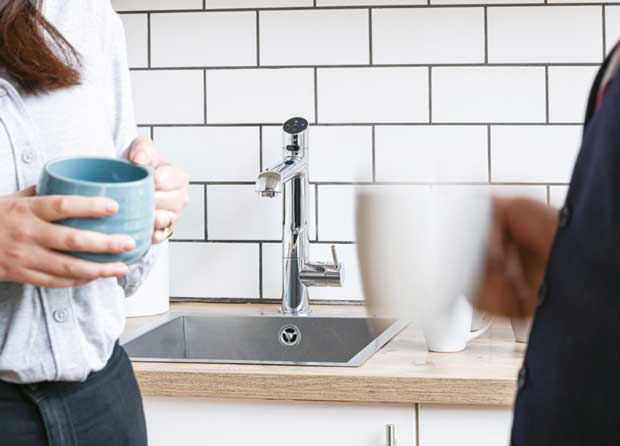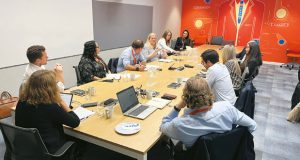HYBRID WORK
Ames also notes that workers’ expectations have changed since the pandemic, for instance regarding a loss of acoustic comfort since returning from home to the workplace. Leesman Index research points to noise as being the biggest issue for any employer looking to pull workers back into the office. It reveals that noise levels are important to 68 per cent of employees and states: “It’s not just about the aesthetics of an office, organisations need to tackle the basics first.”
Another change of habits says Johnson is how people rehydrate. “When we originally put HydroTaps in office spaces, users tended to use cups, mugs or glasses. We’ve now seen a trend towards refillable bottles or flasks as the wellbeing message around hydration, fitness and positive mental health hits home.”
There has of course been a well-documented change in working patterns since 2020. O’Keefe reports that many companies have reduced their office footprint to support more flexible working patterns, resulting in a huge shift in demand.
“On the most popular days that people go into the office, typically Tuesdays, Wednesdays and Thursdays, foodservices are busier than ever before and staff are increasingly interested in more varied food offers, as they’re tired of eating sandwiches at home, which is resulting in greater uptake for workplace restaurants.
“Also, what we’re seeing is that the working day is much longer, with people wanting services to begin earlier and food and drink services offered for longer.”
The need to connect is also a major driver when it comes to creating a healthy workplace environment. Says Oseland: “Quality food and hydration is not just about nourishment but human evolution, as people have come together and shared food, broken bread around the fire and told stories.”
Ames describes designing for ‘meaningful moments’ to foster the sense of belonging that people crave: “If you can engineer this, you can bring people together and create a positive workplace culture.
“Catering for everybody’s needs is the challenge. It’s making sure the workplace is totally inclusive and meets all the different needs of all the different groups of people, not just personas, but work types as well.”
The panel also agrees that it’s vital to create an atmosphere where workers feel respected, valued and trusted. This as Ames describes it is: “Less about presenteeism and more about productivity. Many mid-level to senior managers must change the way that they’re managing, and some are getting it right and some are getting it wrong. But the lesson is that if your community feels valued, then they will perform their work better.”
Johnson relates a change in thinking by customers when installing HydroTaps. “It’s now less because they don’t want people standing around waiting for a kettle to boil, as it’s affecting productivity, but more because managers want these kitchen areas to become a focal point for engagement.”
He adds: “Managers encourage staff to come together in these spaces from a wellbeing perspective, to discuss great ideas, collaborate and de-stress, not just run back to their siloed desk area. It’s an interesting evolution in workplace management.”
MANAGEMENT BUY IN
The podcast concluded with some ideas on how to convince the C-suite that investing in employee wellbeing is worth the cost, even within the current economic climate.
Dan Johnson is optimistic that employers are getting better at listening to their staff, finding ways of giving them a voice and focusing on employee wellbeing.
He says: “Many of the ENPS (Employee Net Promoter Score) surveys help to illustrate the positive results of delivering the areas that staff have asked for. Once you go that step further, you get the next level of productivity. And I think businesses and organisations are starting to recognize that a lot more now, that wellbeing is inherently linked to productivity and happiness and engagement within the workplace.”
Oseland reveals there is a plethora of research available that shows the benefits of investing in wellbeing, by providing a true cost benefit analysis, which isn’t just based on cost and space, but looks at performance and wellbeing benefits.
He says: “I did some work with IWFM on the return on workplace investment, where we looked at 200 studies and started to quantify the impact of good design. It’d be nice to think that we can use that to convince the C-suite.
“But in many ways an easier metric, and one that’s probably most important, is the impact on attraction and retention. If you start to look at some of the surveys out there done by recruiters and so on, they will tell you what people are looking for and importantly why they’re leaving their current jobs.”
 This kind of data is a valuable resource and proof positive of the role of wellbeing in organisational success.
This kind of data is a valuable resource and proof positive of the role of wellbeing in organisational success.
To listen to the podcast go to: https://bit.ly/424EsJh







